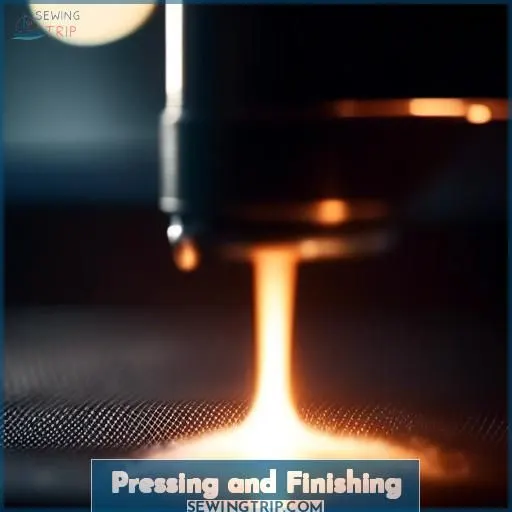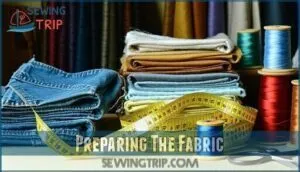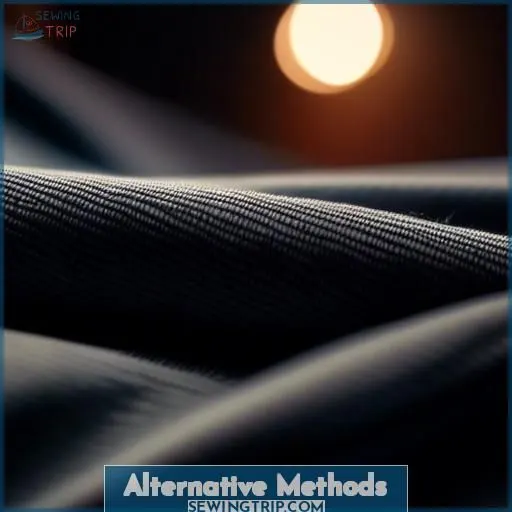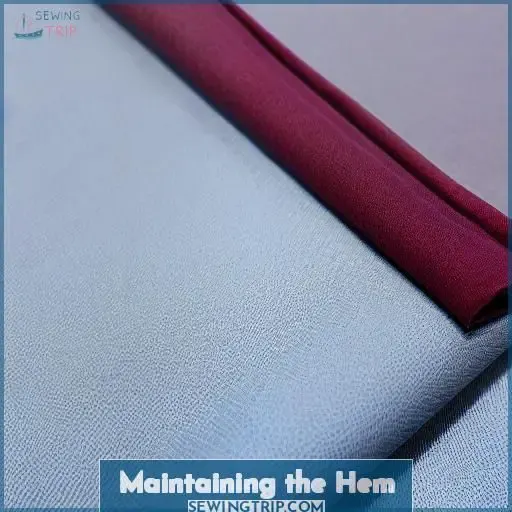This site is supported by our readers. We may earn a commission, at no cost to you, if you purchase through links.
To stop jersey fabric from curling, you can use lightweight interfacing for delicate knits and heavier interfacing for substantial knits. Apply interfacing to areas prone to curling, such as borders. Use a steam iron to remove interfacing if necessary. Select interfacing with elasticity to maintain fabric behavior.
To stabilize the hem, apply iron-on interfacing and use a zigzag stitch, twin needle, or overlock stitch. Use a small zigzag stitch and stitch the hem from the right side for better results.
Press the fabric to smooth out wrinkles before cutting and use pattern weights to flatten rolling edges during cutting. Serging or overcasting edges adds weight and width to prevent rolling. Fusible interfacing on the back of cut edges prevents curling.
For alternative methods, consider using hem tape with a built-in stay or a thin layer of starch on edges. Troubleshoot common issues by avoiding a stitch length that’s too small or tension that’s too tight. Maintaining the hem involves using a straight stitch with a twin needle or overlock stitch.
Table Of Contents
Key Takeaways
- Use appropriate interfacing for delicate and substantial knits to prevent curling.
- Apply interfacing to areas prone to curling, such as borders, and use a steam iron to remove it if necessary.
- Stabilize the hem using iron-on interfacing, lightweight fusible interfacing, or hem tape with a built-in stay.
- Use a small zigzag stitch, twin needle, or overlock stitch to sew the hem from the right side for better results.
How to Stop Jersey Fabric From Curling?
To stop jersey fabric from curling, follow these tips:
- Wash jersey fabric in cool water, turning embellished or patterned clothing inside out and avoiding mixing bright colors and whites in the wash to prevent color bleeding.
- Dry jersey fabric flat or on a washing line, gently pulling it into shape to prevent creases.
- Use a walking foot on your sewing machine to help keep the fabric from stretching and curling while sewing.
- Stabilize the fabric with fusible interfacing or a lightweight knit fusible before sewing.
- Apply starch to the edges of the fabric before sewing to help them stay flat and prevent curling.
- Use a stretch stitch when sewing jersey fabric to allow the fabric to move and stretch without distorting the seam.
By following these tips, you can help prevent jersey fabric from curling during washing, drying, and sewing.
Using Interfacing
When combating the infamous curl of jersey fabric, regard interfacing as your covert ally. Selecting the appropriate interfacing varieties and density is paramount; it resembles selecting the optimal armor for combat. For delicate knits, opt for a lightweight interfacing to avoid introducing volume, while more substantial knits may necessitate something with greater weight.
The interfacing application procedure poses the next obstacle. It extends beyond haphazard placement; precision is imperative. You’ll aim to apply it where the fabric exhibits the greatest tendency to curl, typically along the borders. However, bear in mind, with great power comes great responsibility. Should you encounter a predicament where interfacing removal is necessary, proceed with patience and finesse. A steam iron can serve as your comrade in this endeavor, softening the adhesive for a seamless separation.
Thus, equip yourself with interfacing, and you’ll witness that curling jersey fabric surrendering unconditionally in no time.
Stabilizing the Hem
To stabilize the hem and prevent curling, you can apply a strip of iron-on interfacing before hemming. This method makes sure the hem remains flat even after washing. For thin knits, use lightweight fusible interfacing, and for thicker knits, opt for more substantial interfacing. Another option is to use hem tape with a built-in stay.
When sewing with knits, avoid using a stitch length that’s too small or a tension that’s too tight. These factors can contribute to curling. Instead, use a large zigzag stitch or a straight stitch with a twin needle or overlock stitch.
To further stabilize the hem, you can use pattern weights to flatten rolling edges while cutting. Serging or overcasting edges adds weight and width to prevent rolling. Fusible interfacing on the back of cut edges also prevents curling. For neck bindings and t-shirt hems, fusible tape or hem tape can be used.
Stitching Techniques
To stop jersey fabric from curling, you have a few stitching technique options. One method is to use a small zigzag stitch. This involves stitching one row on the raw fabric edge and another 1cm away. This technique has been reported to prevent curling. Another option is to use wider hems. Hems wider than 15mm are less likely to curl due to the wider stitches that help keep the fabric flat. Avoid using twin needles for hems as they can contribute to curling.
If you prefer a straight stitch, consider using a twin needle or overlock stitch. However, these methods may not completely prevent curling. It’s also essential to avoid using a stitch length that’s too small or tension that’s too tight, as this can exacerbate the curling issue. Stitch the hem from the right side for better results.
For those who want a more permanent solution, you can apply a strip of iron-on interfacing before hemming. This prevents curling even after washing. Use lightweight fusible interfacing for thin knits and more substantial interfacing for thicker knits. Hem tape with a built-in stay can also be used.
Pressing and Finishing
Essential pressing and finishing techniques are key for preventing jersey fabric from curling. Here’s how you can achieve it:
- Pressing Techniques: Begin by pressing the fabric to smooth out wrinkles before cutting. Use a thin layer of starch on edges to flatten curves. Press from the reverse side if required, but always use a pressing cloth and test on a small fabric sample first.
- Finishing Touches: Starch uncurls most knit fabrics and can be easily removed when washing. For rolled edges, spray Terial Magic until moist, hang the fabric to allow the stiffener to absorb, and press as per the manufacturer’s instructions.
- Seam Allowances: Modify seam allowances if trimming edges with a serger. Fusible interfacing on the back of cut edges prevents curling. Fusible tape or hem tape can be used for neck bindings and t-shirt hems. Select interfacing with some elasticity to maintain fabric behavior.
- Starching Methods: Apply a generous amount of starch solely to fabric edges. Insert pins horizontally and vertically, use multiple pins, and remove them while sewing. Position horizontal pins close to the fabric edge.
Preparing the Fabric
Before you begin sewing, it’s imperative to prepare your fabric thoroughly to prevent curling. Here are some suggestions:
- Pattern weights: Utilize pattern weights to flatten rolling edges during cutting. This aids in keeping your fabric level, decreasing the likelihood of curling.
- Edge finishing: Serging or overcasting edges adds weight and width to prevent rolling. Adjust seam allowances if trimming edges with a serger.
- Interfacing: Fusible interfacing on the back of cut edges prevents curling. Fusible tape or hem tape can be used for neck bindings and t-shirt hems. Select interfacing with some stretch to maintain fabric behavior.
- Stiffening and pressing: Press fabric to remove wrinkles before cutting. Use a light layer of starch on edges to flatten rolls. Press from the wrong side if necessary. Use a pressing cloth and test on a small fabric swatch first. Starch uncurls most knit fabrics and washes out easily.
- Terial Magic Treatment: Spray rolled edges with Terial Magic until damp. Hang fabric to allow stiffener to soak in. Press fabric as directed by manufacturer’s instructions. Fabric becomes stiff and flat, allowing for easy sewing. Terial Magic temporarily darkens light fabrics, but washes out easily.
Alternative Methods
After preparing your fabric, let’s explore some alternative methods that’ll prevent your jersey fabric from behaving like a defiant adolescent. Firstly, embrace bias tape as your faithful companion. Encasing the edges with double fold bias tape not only enhances the appearance but also effectively inhibits curling. It’s akin to motivating your fabric before a significant event.
Next, utilize fusible web. This surreptitious ally can be applied to the fabric edges using an iron, forging a bond that discourages curling attempts. Envision it as a clandestine pact between your fabric and a pristine finish.
Remember to calibrate your sewing machine settings. A subtle modification can have a profound impact. It resembles discovering the optimal temperature for your morning beverage—gratifying and essential.
Finally, fabric selection is crucial. Certain fabrics are inherently more compliant than others. It involves choosing compatible materials for your sewing endeavor.
Troubleshooting Common Issues
If you’re experiencing curling hems on your knit fabrics, don’t fret – you’re not alone. Narrow hems, less than 10mm, are more prone to curling, and even using a straight stitch with a twin needle or overlock stitch won’t hinder it. The curling may not be apparent until after the first wash, so it’s crucial to resolve the issue beforehand.
One common cause of curling is tension settings. Make sure your tension isn’t too tight, as this can cause the fabric to pucker and curl. Similarly, avoid using a stitch length that’s too small, as this can also contribute to curling.
If you’re still experiencing issues, consider using a zigzag stitch method. Stitch one row on the raw fabric edge and another 1cm away. This method has been reported to prevent curling. Alternatively, if you’re working with wider hems, those wider than 15mm, the fabric is less likely to curl, and wider stitches help keep the fabric flat.
Maintaining the Hem
Now that you’ve mastered the art of preventing jersey fabric from curling during the hem construction process, it’s time to focus on preserving your hard work. Remember, the key to a well-maintained hem is in the details.
First, consider the stitch length. A longer stitch length can help reduce the likelihood of curling, especially on narrow hems. But be careful not to overdo it, as a stitch length that’s too long can weaken the fabric and cause it to fray.
Next, the fabric type plays a vital role. Different fabrics require different care. For example, knit fabrics may require more frequent ironing to keep them flat, while woven fabrics may be more susceptible to wrinkles.
Speaking of ironing, it’s a common practice to use a hot iron to temporarily flatten out curls. However, be sure to use a pressing cloth and test on a small fabric swatch first to avoid damaging the fabric.
If you’re looking for a twin needle alternative, consider using a zigzag stitch. This technique involves stitching one row on the raw fabric edge and another 1cm away. It’s been reported to prevent curling and is a great option for those who prefer a more decorative hem.
Lastly, don’t forget to keep your hems clean. Regular washing can cause the fabric to stretch and curl, so be sure to follow the care instructions on your fabric’s label. With these tips in mind, your hems will stay flat and fabulous for years to come.
Frequently Asked Questions (FAQs)
What is the best needle to use when sewing with jersey fabric?
To sew with jersey fabric, you should use a ballpoint needle or a stretch needle. These needles have a rounded tip that pushes the fibers aside, preventing holes and snags in the fabric.
Ballpoint needles are suitable for most knit fabrics, while stretch needles are recommended for fabrics with high amounts of stretch caused by elastic threads.
Universal needles can also work for knits, but they aren’t optimized for them like true ballpoint stretch needles.
How can I prevent curling edges on knit fabric?
To prevent curling edges on knit fabric, consider using a zigzag stitch with a small width and length, or try a wider hem method with stitches wider than 15mm. Applying a strip of iron-on interfacing before hemming can also help prevent curling, especially after washing. Choose lightweight fusible interfacing for thin knits and more substantial interfacing for thicker knits.
Hem tape with a built-in stay can also be used. Avoid using a stitch length that’s too small and make sure the tension isn’t too tight. Stitch the hem from the right side for better results.
What is the best stitch to use when sewing with jersey fabric?
To sew with jersey fabric, the best stitch to use is a stretch stitch, which is similar to a lightning stitch or a very narrow and short zigzag stitch. This stitch is flexible and stretches with the fabric, preventing the seams from breaking when stretched.
If your machine doesn’t have a built-in stretch stitch, you can use the zigzag stitch and adjust the width and length to make it more flexible.
Test your stitches on a scrap of your fabric first to make sure they look right and don’t need adjustment.
How can I stop my knit fabric from stretching out of shape during sewing?
To keep your knit fabric from stretching out of shape, use a walking foot or reduce foot pressure. Also, try supporting the fabric evenly and using a differential feed if you’re serging.
What is the best way to hem knit fabric?
To stop jersey fabric from curling during sewing, you can use a few different techniques. One method is to use a zigzag stitch with a small zigzag width, stitching one row on the raw fabric edge and another 1 cm away. This has been reported to prevent curling. Another technique is to use a wider hem, as wider stitches help keep the fabric flat and less prone to curling. Additionally, you can apply a strip of iron-on interfacing before hemming to prevent curling even after washing. If your knit fabric is lightweight, you can use lightweight fusible interfacing, while thicker knits may require more substantial interfacing. Hem tape with a built-in stay can also be used for this purpose.
To further prevent curling, you can avoid using a stitch length that’s too small and make sure the tension isn’t too tight. Stitch the hem from the right side for better results. Use pattern weights to flatten rolling edges while cutting, and serge or overcast edges to add weight and width, preventing rolling. Fusible interfacing on the back of cut edges can also prevent curling. If your fabric is prone to curling, you can use a pressing cloth and test on a small fabric swatch first.
Conclusion
Ironically, the very material that’s renowned for its comfort and ease can cause quite the headache when it starts to curl. But fear not, with these tips and tricks, you’re well-equipped to tackle the issue head-on.
From using interfacing to stabilize the hem, to mastering stitching techniques and employing alternative methods like hem tape, you’ve got all the tools you need to make sure your jersey creations stay flat and fabulous.
















